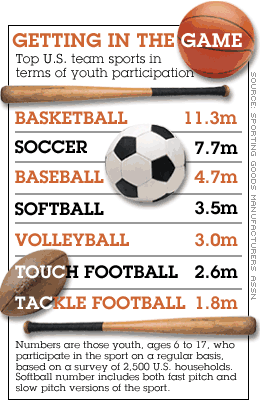
NEW YORK (CNN/Money) -
Soccer fans are convinced they finally have a clean shot at their goal -- soccer as a major U.S. spectator sport.
Giddy following the unexpectedly strong showing by the U.S. team in this year's World Cup and confident that the popularity of youth soccer will provide the large adult fan base of tomorrow, fans flooded me with e-mail after last week's column questioning that premise to proclaim that their sport's future dominance of more established U.S. sports is a certainty.
"In a few years when those (soccer-playing) kids grow up and old geeks like yourself who never had the physical ability to play the sport die off, the sport will flourish," wrote one of my readers last week. "Well, I can't wait for the day."
While I can't dispute the part about my own athletic ability, or lack thereof, soccer fans' other arguments last week don't hold up. Soccer's shot at becoming a major sport here isn't like a penalty kick, which almost always finds the net. It's more like a corner kick, which raises fans' expectations but usually leaves them unfulfilled.

Soccer is one of the top youth sports in the United States, although it's not No. 1, as most of those writing me claimed. According to the Sporting Goods Manufacturers Association's survey of 2,500 households, basketball is the No. 1 sport with 11.3 million children between the ages of 6 and 17 playing it regularly. Soccer has 7.7 million kids playing it, good enough for No. 2 if you count baseball and softball as separate sports, or No. 3 if you combine baseball and softball together, which have about 8 million participants between them.
What's interesting is how little connection there is between the sports we play as children and those we watch as adults.
Touch-football doesn't appear until No. 12 on the list of all sports, with only 2.6 million children participating. Tackle football is No. 17, just behind bowling. Yet football is by and far the most popular spectator sport, with U.S. ratings that tower over any other sport. Nascar is now the nation's second-most popular sport in terms of viewership, even though the level of participation in the sport by those fans is virtually zero.
It seems counterintuitive, but there is a very limited connection between interest in watching a sport and playing it. When there is a connection, I would argue that is more coincidence than cause and effect.
 |
|
| The success of the U.S. team in the World Cup won't help the sport in the United States if stars like Clint Mathis, right, leave for bigger money available overseas. |
Yes, I started watching golf more often on television once I took up the game, but I almost never watch one of the other sports in which I still participate -- skiing.
Youth soccer isn't new. I remember playing it in 1970. My brother-in-law, another 40-something, has grown from an all-division soccer player in high school to an active member of an adult soccer team. But he couldn't tell me the name of two of the nation's professional soccer teams if I threatened to kick him in the shins.
If youth soccer was going to produced a slew of adult soccer fans, it would have started to do it a long time ago.
Soccer isn't the only sport suffering from this disconnect between participation and spectator interest. Millions of Americans who run regularly, including my sister-in-law who has three marathons and a triathlon under her belt, never watch track and field. That hasn't stopped U.S. runners from being among the world's best. But outside of the Olympics, track and field gets virtually no spectator attention here.
As for the theory that the U.S. national soccer team's success will help interest Major League Soccer teams here, the opposite could end up being the case. That's because as U.S. players prove themselves in international competition, it makes them more attractive to overseas club teams, where they can earn more sitting on the bench than being a star here at home.
| |
 SportsBiz
SportsBiz
| |
| | |
| | |
|
Professional sports is becoming globalized -- witness the National Basketball Associations' draft Wednesday that saw China's Yao Ming become the first player taken, and five other overseas players taken in the first round.
That flow of talent to the world's top league or leagues in each sport works against, not for, U.S. soccer teams.
But soccer fans should probably be happy that U.S. television viewers have not embraced the game. Big viewer demands for the sport here would bring the attention of U.S. broadcasters -- none of whom even bothered to bid for the English language rights to the World Cup -- and U.S. advertisers as well.
| |
 Related columns
Related columns
| |
| | |
| | |
|
U.S. television dollars dwarf the medium's revenue in the rest of the world. If those dollars came into play in soccer, it could create pressure for changes that current fans would find sickening -- such as stops in play to show commercials.
If you don't believe that U.S. television dollars can change a sport for the worse, try watching a World Series baseball game that ends before midnight on the East Coast, or count the number of television timeouts in a football game.
Soccer fans hoping for huge U.S. fan interest for their sport are probably lucky that they won't get their wish.

|

